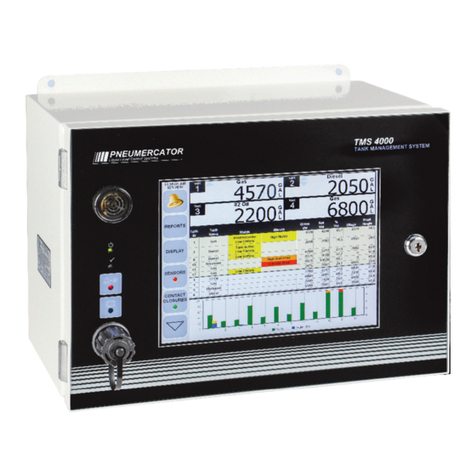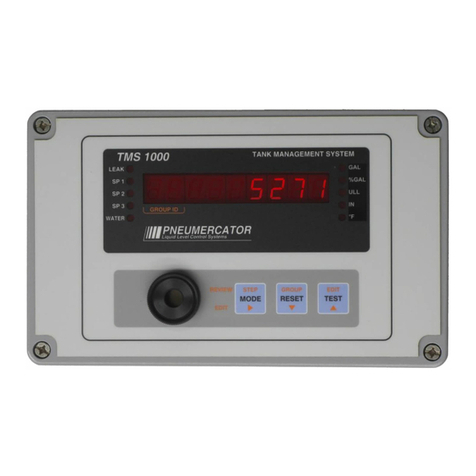
PNEUMERCATOR CO., INC. LDE-740 System
Operation and Installation Manual
Page 10 of 104
Switch Inputs - 8 from any mechanical switch input.
Intrinsically safe for Class I, Division 1, Groups A, B, C, D, 5 VDC @25 mA. Individually
programmable for normally open or normally closed switch inputs.
Output Signals - standard RS-232 Port.
Optional 20-column dot matrix printer.
Leak Detection Sensors - 8 from 9-901, 9-902, and 9-903 sensors.
Intrinsically safe for Class I, Division 1, Groups A, B, C, D, 5 VDC @45 mA. Can be
individually programmed to alternately accept normally open or normally closed
mechanical switch inputs.
Leak Detection Testing - Meets EPA requirements for annual testing and monthly
monitoring.
Hydrocarbon Detection -
Products that are to be detected must be non-conductive fluids having a dielectric value of
between 2 and 12.
9-901: 0.33”, 100% pfd, 0% pfa @ 0.1 gph.
9-902: 0.35", 100% pfd, 0% pfa @ 0.1 gph.
9-903: 0.68", 100% pfd, 0% pfa @ 0.1 gph.
Leak Detection Response Time - Less than 1 second for detection, 1 minute for alarm latch.
Leak Detection Indicators -
Red led indicates oil detection.
Amber led indicates water detection.
Green led indicates dry (normal condition).
Level Transmitter/Sensor Operating Temperature -
2-412, 2-501 Level Transmitters: -20 ºF to 180 ºF (-29 ºC to 82 ºC).
9-901, 9-902, 9-903 Sensors: -40 ºF to 130 ºF (-40 ºC to 55 ºC).
LS600 Switch Sensors: -20 ºF to 180 ºF (-29 ºC to 82 ºC).
LS600LD Leak Sensors: -40 ºF to 160 ºF (-40 ºC to 71 ºC).
Level Transmitter/Sensor Operating Pressure -
2-412 Level Transmitter: to 50 psi.
2-501 Level Transmitter: to 15 psi.
9-901, 9-902, 9-903 Sensors: ambient (vented).
LS600 Switch Sensors: to 150 psi.
LS600LD Leak Sensors: to 100 psi.
Level Transmitter/Sensor Cable -
2-412, 2-501, 9-901, 9-902, 9-903: Standard 3 conductor #18 AWG,
2-412 and 2-501 up to 2200 feet. 9-900 sensors up to 1000 feet.
Switch sensors: Standard 2 conductor #18 AWG, up to 2200 feet.





























